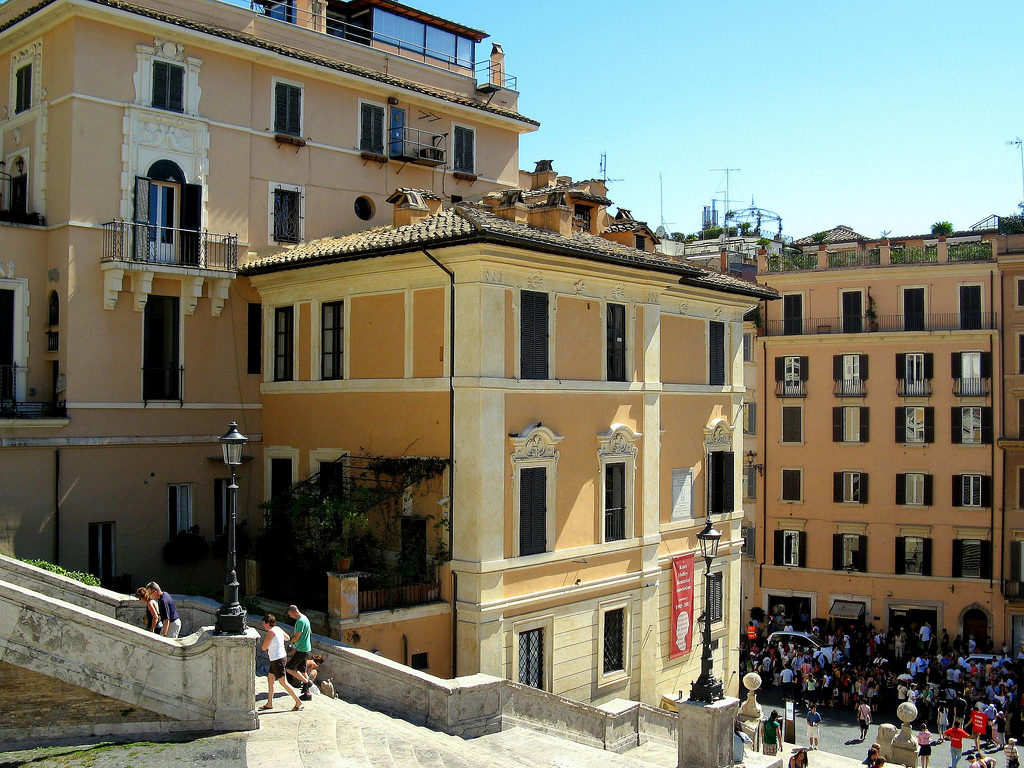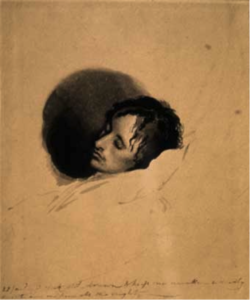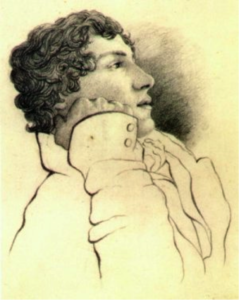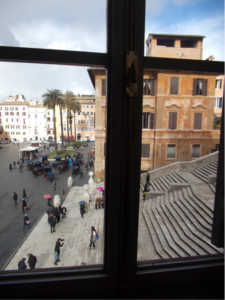By AMY WELDON

Hoisting our backpacks, my students and I start up a narrow staircase that points us left and right. In November 1820, John Keats and his friend Joseph Severn climbed these stairs to two small rooms above the Spanish Steps, ready to stay until the end, which they knew wouldn’t be far away. Nevertheless, they rented a piano. Getting that piano back downstairs must have been a nightmare. Not to mention the armloads of drapes and rugs, and the sheets and the pillows, and the mattress, stained with sad rings of blood. But it was the law: all movable furnishings of a consumptive’s sickroom, even the wallpaper, must be burned. And then, on a late February day in 1821, would have come the carrying-down of Keats’ small body itself: a twenty-five-year-old man, five feet tall and wasted to the weight of an adolescent, the luminous eyes closed for good.
When Keats and Severn arrived here, the small apartment was bisected by a heavy curtain: their landlady, Signora Angeletti, at the back, due scapoli inglesi in the front. Now it’s a cozy library lined with books and memorabilia: paintings, letters, locks of hair. Overlooking the Spanish Steps is the tiny room in which John Keats died. Stretch out both arms and you can almost touch each wall. There’s a narrow bed and a little writing table, yet only the large window and the fireplace and the ceiling, carved and painted with white daisies on a blue background, are original. In his last days Keats sent Severn to the Protestant Cemetery at the edge of Rome for some reconnaissance. It’s peaceful, Severn reported back, with little white daisies growing in the grass. Hearing this, Keats is said to have raised his eyes to the flowered ceiling and – every instinct tells me – smiled. I think, he said, I can feel them growing over me even now. What rueful complexities must have flickered in that smile.
Poor Severn, who’d come from England to help his friend and maybe work on his painting, had no idea what he was getting into. In his letters, he’s often overwhelmed, on the verge of tears, especially in the days after Keats’ death. “Those brutal Italians have nearly done their monstrous business,” he raged. “They have burned the furniture…they have racked me in my most painful moments.” When bossy Signora Angeletti presented him with a heap of broken dishes, and a bill for them, he smashed them all with his walking stick. But Severn didn’t run. To keep himself awake during a night watch on January 28, he drew Keats’ face on the pillow in front of him: the eyes swollen with sleep, the hair glued with sweat to the wide forehead, the deceptive calm. “Poor Keats keeps me by him,” he wrote to his friend William Haslam, “and shadows out the form of one solitary friend – he opens his eyes in great horror and doubt – but when they fall upon me – they close gently and open and close until he falls into another sleep – The very thought of this keeps me by him until he dies.”

Deathbed sketch of Keats by Joseph Severn, 1821. Via Keats-Shelley House website.
As a poet, Keats knew this himself: maintaining a steady, attentive presence in the face of any emotion can make the body a means of knowledge. Like the physician he once trained to be, he sits beside his own mind to take its pulse, diagnosing and participating in its interactions with the world. Sometimes he’s analogizing, as when praising his friend Leigh Hunt’s work in 1817: “that sentence about making a Page of the feelings of a whole life appears to me like a Whale’s back in the Sea of Prose.” (Great goal for a sentence, isn’t it?) Sometimes he’s rapt, transported, as in desire for his next-door neighbor and great love Fanny Brawne: “You have absorb’d me,” he writes in October 1819, “I have a sensation at the present moment as though I was dissolving—” Sometimes he’s transported by some other inwardness, as in a sketch by his friend and roommate Charles Brown, chin propped on his hand.

Sketch of Keats by Charles Brown, 1819 (Wikimedia Commons)
But look at that hand, big-knuckled and capable. Before he was a poet, Keats was an ostler’s son and apprentice physician, always rooted in the body as our primary means of experiencing the world. His letters to his siblings and friends – forward-hurtling, with headlong dashes and idiosyncratic spelling – still show us this. “I scarcely remember counting upon any Happiness,” he wrote in 1817, “I look not for it if it be not in the present hour – nothing startles me beyond the Moment. The setting sun will always set me to rights – or if a Sparrow come before my Window I take part in its existince and pick about the Gravel.” Any spur to his imagination crosses him into other bodies, other lives. “I go among the Feilds,” he wrote in March 1819,
and catch a glimpse of a stoat or a fieldmouse peeping out of the withered grass – the creature hath a purpose and its eyes are bright with it – I go amongst the buildings of a city and I see a Man hurrying along – to what? The Creature has a purpose and his eyes are bright with it. But then as Wordsworth says, “we have all one human heart” – there is an ellectric fire in human nature tending to purify – so that among these human creature[s] there is continually some birth of new heroism – The pity is that we must wonder at it: as we should at finding a pearl in rubbish –
Keats developed his famous idea of negative capability, I think, out of just this sort of crossing-over – being on a border and waiting to see what’s there – in a moment he shared with his brothers in 1817:
…several things dovetailed in my mind, & at once it struck me, what quality went to form a Man of Achievement especially in Literature & which Shakespeare posessed so enormously – I mean Negative Capability, that is when man is capable of being in uncertainties, Mysteries, doubts, without any irritable reaching after fact & reason –
A child seeks the simple resolution, the absolute rule, the black or white. An adult knows it’s more complicated.
Dwelling in complication made Keats peculiarly wise and tough. His father died from a fall from a horse when he was eight. His mother left the family when he was nine, returning after four years to die of consumption. Young Keats kept vigil outside her sickroom, then hurled himself into his studies in futile hopes that his success could earn her life. At twenty-two, he was apprenticed as a dresser at Guy’s Hospital in central London. Keats’ job was to hold instruments, replace blood-soaked boxes of sawdust under the operating table with fresh ones, and hold down screaming patients. “My last operation,” he told Brown, “consisted in opening a man’s temporal artery. I did it with the utmost nicety, but reflecting on what had passed in my mind at the time, my dexterity seemed a miracle – I never took up the lancet again.” Very soon, he’d be nursing his younger brother Tom, also fatally consumptive, in a small room in Hampstead. On a bench just down the street from that room, friends would later find him collapsed and sobbing, having discovered the disease in himself. Riding on the outside of a coach – the cheap seats – in a storm had brought on a coughing fit he couldn’t deny. “I am not deceived,” he told Brown, who helped put him to bed. “I know the color of that blood, it is arterial blood – I must die.” It was February 1820. One year later, he’d be gone.
Yet as the scholar Alan Richardson writes, Keats’ medical training informed his sense of how the body experiences the world through nerve and bone; all that blushing, drowsiness, and aching of the great odes of 1819 owe something to his early dissections and the notebooks he filled during lectures. Like many another medical student, he developed a sense of a ghost in the machine, some always-escaping essence animating and expressed in but not limited to a single body, something that in an 1818 letter he called “the poetical Character:”
[I]t is not itself – it has no self – it is every thing and nothing – It has no character – it enjoys light and shade; it lives in gusto, be it foul or fair, high or low, rich or poor, mean or elevated … What shocks the virtuous philosop[h]er, delights the camelion Poet….A Poet is the most unpoetical of any thing in existence; because he has no Identity – he is continually in for – and filling some other Body–
Keats filled the body of this house in Rome, and it filled him, even though he seldom left that room, which would have chimed, in quiet moments, with Bernini’s fish-mouthed fountain splashing underneath. Outside, a stone plaque marks him, ignored by many of the flower-sellers and selfie-stickers wandering past. While Byron’s rented palazzo on the Grand Canal in Venice is plaqued with his English name – “Qui Abitò Lord Byron,” a slash of English like a sword-cut in a drawing-room couch – Keats is named here in Italian first: “L’inglese poeta Giovanni Keats mente maravigliosa quanto precoce morì in questa casa li 24 febraio 1821, ventesimosesto dell’eta’ sua.” The English translation following it – “The young English poet John Keats died in this house on the 24th February 1821 aged 25” – does not capture the sense, or the sadness, of mente maravigliosa quanto precoce. A full translation might be “Keats, whose mind was as marvelous as it was precocious,” although I secretly prefer Google’s blunt phrase: “a marvelous early mind.”
Standing with students at Keats’ grave in the Protestant Cemetery, I read aloud, swallowing tears, this fragment, written sometime after the great Odes in 1819:
This living hand, now warm and capable
Of earnest grasping, would, if it were cold
And in the icy silence of the tomb,
So haunt thy days and chill thy dreaming nights
That thou would wish thine own heart dry of blood
So in my veins red life might stream again,
And thou be conscience-calm’d–see here it is–
I hold it towards you.
The bold gesture fits the young people standing all around this young poet’s grave: Look around you, he challenges us. Open your mortal eyes and gaze upon this world while you still can. Irises grow above him; little white daisies star the grass. “Look,” students whisper to me as we walk away from the grave, wiping our eyes. “Severn was right. There are daisies here. He would have come out here in January to report back to Keats. And it’s January now.”
When Keats lay dying in that room in Rome, he knew two things: one, that he would not recover. Two, that he would never again see Fanny Brawne. He believed a third thing: that he would die forgotten, that all his poetry had been for nothing. In his pain he raged at his “posthumous existence,” lying in that small room without even the strength for the prankishness of his early days in Rome, when he emptied plates of bad food from the local traittoria out his window in protest. (“We will soon have an excellent dinner,” he told Severn afterwards; he was right.)
But my students and I know what he could not: that his poetry would be remembered, that it would move us to sympathetic tears, starting deep in our own nerves, almost two hundred years later, as the scrappy dreaming spirit of that small body crosses into our own. Standing in his room with them, I was startled to hear rain pattering the steps outside, although the sun was shining – a form of negative capability, two apparent contraries creating a third thing – sun and rain together turning the world rosy gold, seen forever through the light cast by a marvelous early mind, too early lost.

View from Keats’ window. Photo by Amy Weldon, January 2013.
A note: Thanks to the kind and knowledgeable staff of the Keats-Shelley House in Rome and to the sources I consulted – Stanley Plumly’s Posthumous Keats; Nicholas Roe’s John Keats: A New Life; Letters of John Keats: A Selection, edited by Robert Gittings; and Sally Brown’s essay “Suppose Me In Rome” in Keats and Italy: A History of the Keats-Shelley House in Rome. Thanks to Anita Miller for wonderful walking tours of Hampstead and to Ruth Caldwell for speedy and nuanced Italian consultation. I also never miss an opportunity of pointing readers to Dean Young’s poem “I See A Lily On Thy Brow” (in his collection Skid, 2002), which imagines John Keats as a medical student.
Amy Weldon is associate professor of English at Luther College and author of the forthcoming book The Hands-On Life: How to Wake Yourself Up and Save The World.



